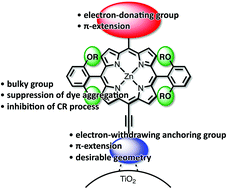Porphyrins as excellent dyes for dye-sensitized solar cells: recent developments and insights
Abstract
Dye-sensitized solar cells (DSSCs) have attracted much attention as an alternative to silicon-based solar cells because of their low-cost production and high power conversion efficiency. Among various sensitizers, numerous research activities have been focused on porphyrins due to their strong absorption bands in the visible region, versatile modifications of their core, and facile tuning of the electronic structures. In 2005–2007, Officer and Grätzel et al. had achieved a rapid increase in the power conversion efficiency of porphyrin DSSCs from a few percent to as much as 7%. Encouraged by these pioneering works, further high-performance porphyrin dyes have been developed in the last decade. These studies have provided us profound hints for the rational design of sensitizers toward highly efficient DSSCs. Push–pull structures and/or π-extensions have made porphyrins panchromatic in visible and even near-infrared regions. Consequently, porphyrin sensitizers have exhibited power conversion efficiencies that are comparable to or even higher than those of well-established highly efficient DSSCs based on ruthenium complexes. So far the power conversion efficiency has increased up to ca. 13% by using a push–pull porphyrin with a cobalt-based redox shuttle. In this perspective, we review the recent developments in the synthetic design of porphyrins for highly efficient DSSCs.


 Please wait while we load your content...
Please wait while we load your content...